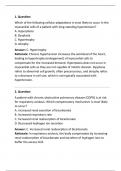Exam (elaborations)
NUR2063 / NUR 2063 Pathophysiology Essentials (2024/2025 Final Exam Update) | Review Guide with 100% Correct Answers for Top Grades - Rasmussen (successus)
- Course
- Institution
NUR2063 / NUR 2063 Pathophysiology Essentials (2024/2025 Final Exam Update) | Review Guide with 100% Correct Answers for Top Grades - Rasmussen (successus)
[Show more]



